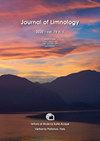阿根廷巴塔哥尼亚梯级水库系统沿岸微微浮游生物群落的空间变化
IF 1.1
4区 环境科学与生态学
Q4 LIMNOLOGY
引用次数: 1
摘要
本文研究了阿根廷巴塔哥尼亚Limay河Alicura、Piedra del Águila和Ramos Mexía三个低中营养级联水库中浮游生物群落结构和多样性的变化。我们分析了空间变化,覆盖了从安第斯山脉到草原的262公里梯度的地理和地理延伸,并对利梅河(Collon Cura)的主要富裕区进行了采样。在所有采样点测量了主要的湖泊变量,并通过流式细胞术分析了浮游生物丰度(自养和异养)。采用Illumina MiSeq高通量测序技术评估细菌多样性。我们预计沿这一系列梯级水库的营养状态会增加,这将决定浮游生物群落结构的空间差异。我们还假设,沿着系统的逻辑和逻辑条件会影响细菌组成。结果表明,在Ramos Mexía水库下游,营养状态略有增加,浮游生物总体丰度也有所增加。Picocyanobacteria在整个系统中以富含藻红蛋白的细胞为代表,与描述的低营养水生生态系统的模式一致。基于细菌OTU组成和环境变量的多变量分析表明,各站点的空间排序遵循下游营养状态增加的趋势。细菌OTU多样性的分子分析也显示出丰富度的增加和均匀度的减少,而在水库中则相反,这表明保水时间可能对群落组成的结构起作用。本文章由计算机程序翻译,如有差异,请以英文原文为准。
Spatial variation of picoplankton communities along a cascade reservoir system in Patagonia, Argentina
In this study we explored how picoplankton community structure and diversity varied along three cascade oligo-mesotrophic reservoirs of the Limay River (Patagonia, Argentina): Alicura, Piedra del Águila and Ramos Mexía. We analyzed the spatial changes, covering lotic and lentic stretches along a gradient of 262 km from Andes to steppe, and we also sampled the main affluent of the Limay River (Collon Cura). In all sampling sites the main limnological variables were measured, and the picoplankton abundance (autotrophic and heterotrophic) was analyzed by flow cytometry. The bacterial biodiversity was assessed using high throughput sequencing Illumina MiSeq. We expected an increase in the trophic state along this series of cascade reservoirs, which would determine spatial differences in the structure of the picoplankton communities. We also hypothesized that the lotic and lentic conditions along the system would influence the bacterial composition. The results showed a slight increase in trophic state together with an increase in overall picoplankton abundance downstream, towards Ramos Mexía Reservoir. Picocyanobacteria were represented by phycoerythrin-rich cells all along the system, in accordance to the pattern described for oligotrophic aquatic ecosystems. Multivariate analyses based on bacterial OTU composition and environmental variables showed a spatial ordination of sites following the trend of increasing trophic state downstream. Molecular analyses of bacterial OTU diversity also showed an increase in richness and a decrease in evenness at the lotic stretches, and the opposite pattern in the reservoirs, suggesting that water retention time may play a role in structuring the community composition.
求助全文
通过发布文献求助,成功后即可免费获取论文全文。
去求助
来源期刊

Journal of Limnology
地学-湖沼学
CiteScore
2.70
自引率
6.20%
发文量
12
审稿时长
3 months
期刊介绍:
The Journal of Limnology publishes peer-reviewed original papers, review papers and notes about all aspects of limnology. The scope of the Journal of Limnology comprises the ecology, biology, microbiology, physics, and chemistry of freshwaters, including the impact of human activities, management and conservation. Coverage includes molecular-, organism-, community-, and ecosystem-level studies on both applied and theoretical issues. Proceedings of workshops, specialized symposia, conferences, may also be accepted for publication.
 求助内容:
求助内容: 应助结果提醒方式:
应助结果提醒方式:


